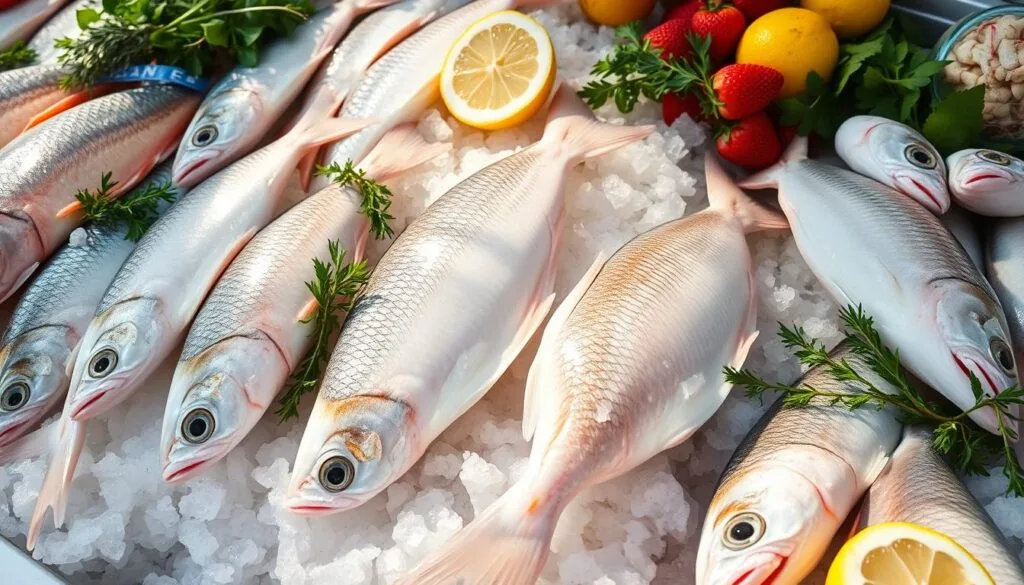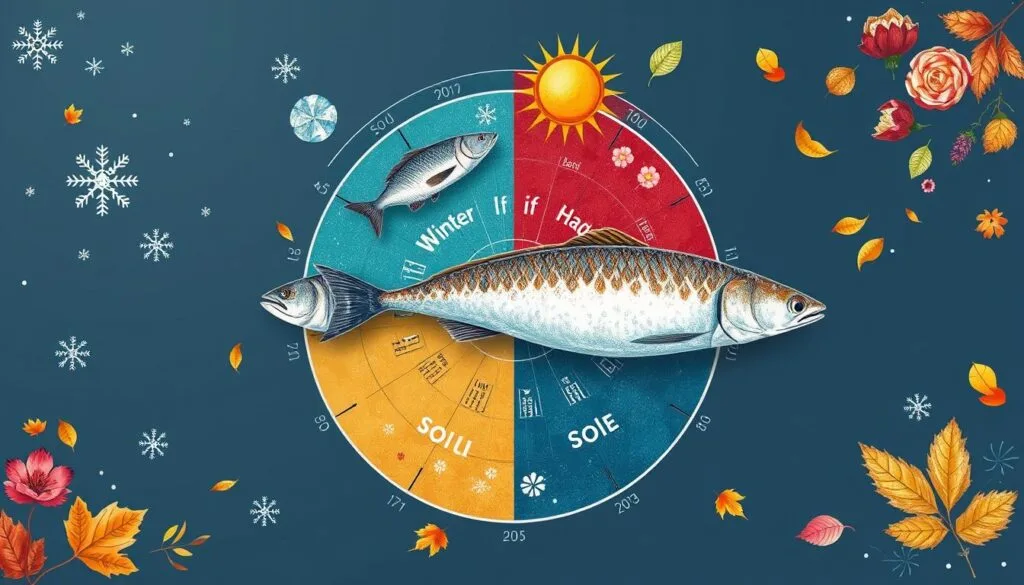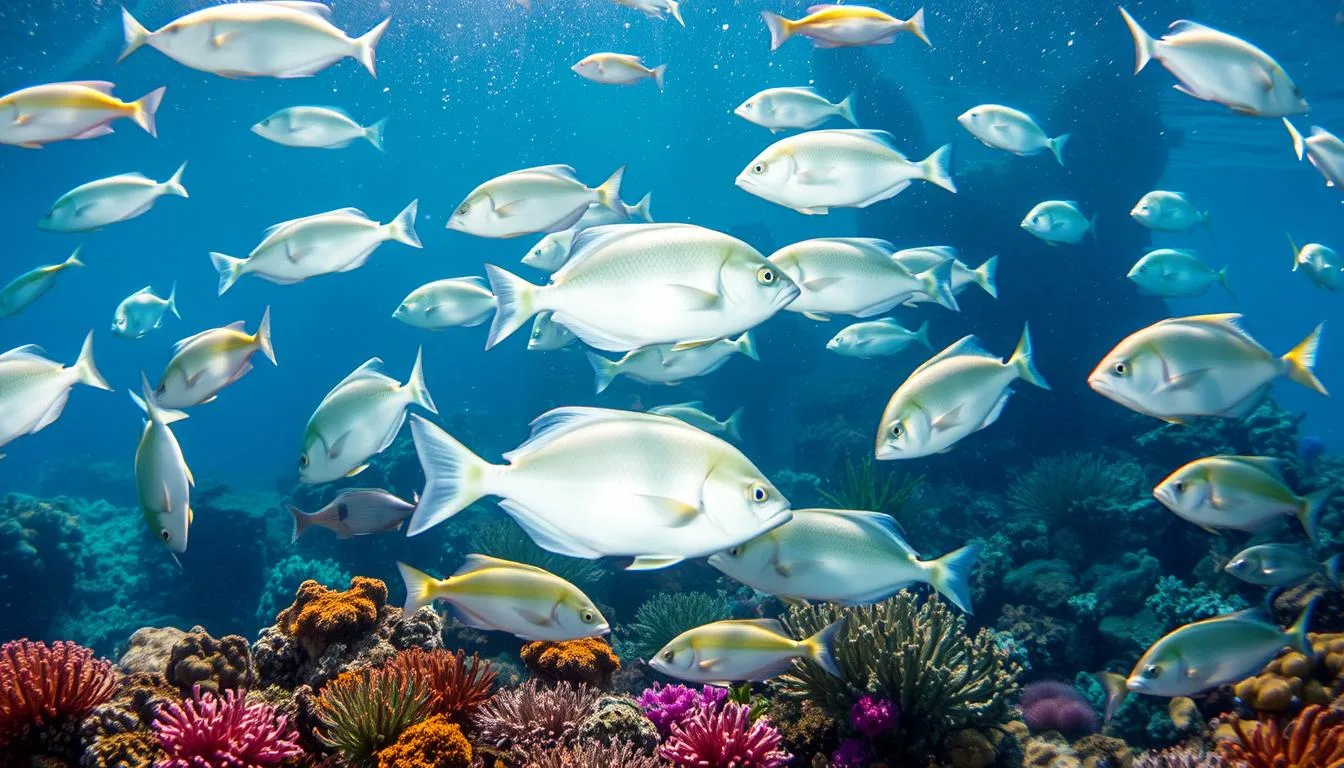Discover the Types of White Fish
White fish is a term for fish with pale, firm, and mild flesh. You can find many types like branzino, catfish, cod, and pollock. These are favorites for both home cooks and chefs because they’re versatile. They have a delicate taste and flaky texture, great for many cuisines.
White fish is lean and has a mild flavor. It’s low in oil, making it a good choice for a light seafood meal. With so many options, you’re bound to find one that fits your taste and cooking style. Each type, from cod to halibut, brings something special to the table.
Table of Contents
Understanding White Fish: What Makes It Different
Exploring white fish reveals a wide range of species, each with its own traits. Cod, haddock, and halibut are known for their mild taste and firm texture. Sole and sea bass, on the other hand, are loved for their delicate flavor and cooking versatility.
White fish stand out because of their diet. They eat plankton and algae, which makes them leaner and milder in taste. This makes them a great choice for those seeking a low-fat protein option. Knowing the differences between white fish and other fish is crucial.
Characteristics of White Fish
White fish are lean and have tender muscles. They are packed with vitamins and minerals like vitamin D, selenium, and potassium. Some, like pollock and cod, also have omega-3 fatty acids, though less than oily fish.
White Fish vs. Oily Fish
White fish and oily fish are quite different. Oily fish, such as salmon, have more fat and a bolder taste. White fish, however, are milder and more delicate, perfect for various cooking methods.
Texture and Flavor Profiles
The texture and taste of white fish vary by species. Halibut is firm and slightly sweet, while sole is delicate and flaky. Knowing these differences helps you pick the right white fish for your dish.
Common Types of White Fish in American Markets
In American markets, you’ll find many white fish options. Some popular ones are cod, haddock, pollock, flounder, tilapia, and sole. Each top white fish choice is great for different cooking ways.
Some white fish options stand out for their health benefits. Cod is rich in vitamins A, D, B3, B6, and B12. Halibut is high in potassium, iron, and omega-3s, making it a favorite among health experts.
Here are some key facts about common white fish options:
- Cod: high levels of B vitamins, selenium, iodine, and omega-3 fatty acids
- Halibut: higher potassium, iron, and omega-3 percentages compared to cod
- Pollock: higher levels of vitamin B12, iron, and omega-3 fatty acids
When picking top white fish choices, think about taste, texture, and cooking uses. With so many white fish options, you’ll find the perfect one for your next meal.
Nutritional Benefits of White Fish Species
White fish is a nutrient-rich food that offers many health benefits. It is high in protein, low in fat, and packed with essential nutrients. These include omega-3 fatty acids, vitamin B12, and minerals like selenium and phosphorus.
Some top white fish varieties are cod, halibut, haddock, sole, and flounder. They are not only tasty but also provide a range of nutritional benefits. For instance, cod is low in calories and fat, while halibut is a great source of protein and omega-3 fatty acids.
Here are some key nutritional benefits of different white fish species:
- Cod: low in calories and fat, excellent source of protein, vitamin B12, and omega-3 fatty acids
- Halibut: rich in protein and omega-3 fatty acids, contains vitamins B6 and B12, magnesium, and potassium
- Haddock: excellent source of protein, selenium, and phosphorus, contains omega-3 fatty acids
- Sole: rich in protein, low in calories and fat, contains vitamins D and B12
- Flounder: low in calories and fat, good source of protein, vitamins B12 and niacin
Eating types of white fish can help your heart, reduce inflammation, and boost brain function. With so many best white fish varieties to pick from, you can enjoy a tasty and healthy meal that fits your diet.
| Fish Species | Protein Content | Calories | Fat Content |
|---|---|---|---|
| Cod | 20g | 120 | 1g |
| Halibut | 25g | 140 | 2g |
| Haddock | 22g | 130 | 1.5g |
| Sole | 20g | 110 | 1g |
| Flounder | 18g | 100 | 0.5g |
How to Select Fresh White Fish
Choosing fresh white fish involves several important factors. You want to pick species that are tasty and good for the environment. With many options, it can be hard to decide. Look for firm flesh, clear eyes, and a fresh smell.
Avoid fish with a bad smell or discolored flesh. These signs mean the fish is not fresh.
Buying fish close to where it’s caught is best for quality. There are two types of fish consumers: those who love cooking fish and those who are new to it. For beginners, knowing about freshness is key. Freshness goes down the longer fish is out of water.
Ask your fishmonger about the fish’s origin and freshness. This helps you make a smart choice.

Popular white fish include cod, haddock, and halibut. For guidance, check out Seafood Watch, the Aquaculture Stewardship Council, and the Marine Stewardship Council. They provide info on sustainable seafood choices.
Choosing fresh, sustainable white fish means you’ll enjoy a tasty meal. Plus, you’ll help protect our oceans.
Keep your white fish in the coldest fridge part for up to two days. Or store it on ice if you can. With practice, you’ll get better at picking and cooking white fish. Freshness and sustainability are key to a great meal, whether you’re a fish lover or new to it.
Popular Cooking Methods for White Fish
Choosing the right cooking method is key when cooking white fish. Cod, tilapia, and halibut are top choices. Each can be cooked in different ways to enhance their taste and texture.
Popular methods include baking, broiling, pan-frying, and grilling. The best method depends on the fish type and the flavor you want.
Cooking Techniques for White Fish
Baking is great for cod and tilapia, keeping them moist and flavorful. Broiling works well for thicker fish like halibut and grouper. For delicate fish like sole and flounder, pan-frying is better. Grilling suits fish with a meaty texture, like swordfish and tuna.
- Baking: Preheat your oven to 350 degrees and cook for 15-20 minutes, or until the fish is cooked through.
- Broiling: Preheat your broiler and cook for 5-7 minutes per side, or until the fish is cooked through.
- Pan-frying: Heat a skillet over medium-high heat and cook for 3-5 minutes per side, or until the fish is cooked through.
- Grilling: Preheat your grill to medium-high heat and cook for 5-7 minutes per side, or until the fish is cooked through.
By picking the right cooking method, you can make delicious, healthy meals. These are perfect for any time.
| Cooking Method | White Fish Type | Cooking Time |
|---|---|---|
| Baking | Cod, Tilapia | 15-20 minutes |
| Broiling | Halibut, Grouper | 5-7 minutes per side |
| Pan-frying | Sole, Flounder | 3-5 minutes per side |
| Grilling | Swordfish, Tuna | 5-7 minutes per side |
Sustainable White Fish Options
Choosing the right white fish is important. Overfishing harms many fish stocks. It’s key to pick varieties that are caught or farmed responsibly. The Marine Stewardship Council (MSC) certification shows if fishing is done right.
Wild-caught Alaska pollock and U.S. farmed tilapia are good choices. They taste great and are good for the planet. By picking these, you help the oceans stay healthy. Every choice you make can help our food system be better.
Here are some important points to think about when picking sustainable white fish:
- Over 550,000 metric tonnes of MSC labelled whitefish products were sold worldwide in 2023-24.
- Whitefish fisheries account for almost three quarters of the global whitefish catch engaged with the MSC’s sustainable seafood program.
- The MSC certified Icelandic lumpfish fishery has successfully implemented measures to reduce bycatch.
Choosing sustainable white fish means you’re eating well and helping the planet. Next time you’re shopping or eating out, ask about the fish’s sustainability. It’s a small step that makes a big difference.
Best White Fish for Specific Dishes
Choosing the right white fish can make your dishes taste amazing. Different white fish species are better for different recipes. For example, cod and haddock are great for fish and chips because of their firm texture and mild taste.
Tilapia and mahi-mahi are better for fish tacos. They have a softer texture and a delicate flavor. For baked dishes, firmer fish like halibut or sea bass are best. They keep their shape well and soak up flavors nicely.
Fish and Chips Options
Cod and haddock are perfect for fish and chips. They have lots of protein and not much fat. A 100g serving of cod has 18g of protein, 0.7g of fat, and only 82 calories. Haddock has 20g of protein, 0.6g of fat, and 90 calories per 100g, making them great choices.
Fish Tacos Selections
Tilapia and mahi-mahi are great for fish tacos. They are tender, mild, and low in fat and calories. A 100g serving of tilapia has 20g of protein, 1g of fat, and 110 calories. Mahi-mahi has 20g of protein, 0.5g of fat, and 90 calories per 100g, making them excellent options.
Baked Dish Recommendations
Firmer fish like halibut or sea bass are perfect for baking. They stay moist and flavorful. Halibut has 20g of protein, 2g of fat, and 110 calories per 100g. Sea bass has 18g of protein, 2g of fat, and 100 calories per 100g, making them ideal for baked dishes.
Seasonal Availability Guide
Knowing when different white fish are in season can help you save money. For example, halibut is more common in spring and summer. Cod, on the other hand, is available all year.
When planning meals, think about the best times for each white fish. Seasonal seafood availability changes, with some fish being more plentiful at certain times. Spring and summer, for example, bring a variety of fish like haddock, dabs, and grey sole.
Spring and Summer Options
In spring and summer, you can find fresh haddock, dabs, and grey sole. Haddock is a favorite in New England, found on menus and in markets. Dabs, or American plaice, have thin, delicate fillets and are from the Gulf of Maine. Grey sole is a summer favorite with a mild taste and soft fillet.

Fall and Winter Choices
In fall and winter, try hake, monkfish, and sea bass. Hake is like Atlantic cod but less known, with firm, mild fillets. Monkfish has firm flesh and is great for many cooking methods. Choosing seasonal white fish means you get fresh, quality products and support sustainable fishing.
Storage and Preparation Tips
Storing types of white fish right is key. Keep them in the coldest part of the fridge and use them in 1-2 days. For longer storage, freeze them at 0°F (-18°C) or below. This keeps the fish quality and safe.
To store white fish, follow these steps:
- Keep them in a sealed container or bag to prevent moisture and other flavors from affecting the fish.
- Label the container with the date and type of fish, so you can easily keep track of how long it’s been stored.
- Store them in the coldest part of the refrigerator, usually the bottom shelf.
When preparing types of white fish, handle them gently. Clean and fillet them, then marinate or season to boost their flavor. Try lemon and herbs, garlic butter, or cajun seasoning.
Here’s a table summarizing the storage guidelines for different types of fish:
| Type of Fish | Refrigerator Storage | Freezer Storage |
|---|---|---|
| Lean Fish (cod, halibut, tilapia) | Up to 2 days | Up to 6 months |
| Fatty Fish (salmon, mackerel, tuna) | Up to 1 day | Up to 3 months |
| Whole Fish | Up to 1 day | Not recommended |
By following these tips, you can enjoy your best white fish varieties at their best. Always handle the fish gently and store them right to keep their quality and safety.
Conclusion: Making the Most of White Fish Varieties
The world of white fish is full of tasty options. You can find everything from tilapia’s mild taste to halibut’s firm sweetness. Each fish has its own flavor, making it easy to find the perfect one for any dish.
White fish is also great for your health. They are high in protein and low in calories. This makes them perfect for anyone looking to eat well without sacrificing taste.
As you try new recipes, don’t forget to explore all the white fish out there. Try different cooking methods and find new flavors to enjoy. With this guide, you’re ready to dive into the exciting world of white fish.
FAQ
What defines a fish as “white” and why are white fish varieties popular?
White fish are known for their mild taste and versatility in cooking. They have less fat and a firmer texture than oily fish. This makes them a favorite among both home cooks and chefs.
What are the key differences between white fish and oily fish?
White fish and oily fish differ in several ways. White fish are firmer and have less fat. Oily fish are softer and have more fat.
What are the most common white fish varieties found in American markets?
In American markets, you’ll find cod, haddock, pollock, flounder, tilapia, and sole. Each has its own taste and texture, perfect for different dishes.
What are the nutritional benefits of incorporating white fish into one’s diet?
White fish is a great source of protein. They offer a range of nutrients, making them good for muscle building, weight management, or a balanced diet.
What are the signs of fresh white fish and how can one ensure they are making sustainable choices when purchasing?
Look for clear eyes, bright gills, and firm flesh when buying white fish. Choosing sustainable fishing practices and understanding certifications helps make eco-friendly choices.
What are the best cooking techniques for different types of white fish?
White fish can be baked, broiled, pan-fried, or grilled. Each method has its own technique and temperature. Choose the right method for the fish’s texture and flavor.
Which white fish varieties are considered the most sustainable options?
Some white fish are more sustainable than others. Knowing which ones are sustainable helps make eco-friendly choices without sacrificing taste or quality.
How can one select the ideal white fish for popular dishes like fish and chips, fish tacos, and baked dishes?
The right white fish for dishes like fish and chips or fish tacos depends on its texture and flavor. Understanding these can lead to delicious results in various recipes.
How does the seasonal availability of white fish affect purchasing and cooking choices?
Knowing when different white fish are in season helps plan meals and save money. It also lets you try new varieties as they become available.
What are the best practices for storing and preparing white fish to maintain quality and safety?
Proper storage and preparation are key to keeping white fish fresh. This includes refrigeration, freezing, thawing, and techniques like cleaning and marinating. These steps enhance the fish’s flavor and quality.
Source Links
- Types of White Fish | Vital Choice – https://www.vitalchoice.com/articles/food-facts/types-of-white-fish?srsltid=AfmBOoriyaTAT53LmJBLYvxrv-pZT6n1atltBjYpYaNDiUzJ7Ur7Uy3h

